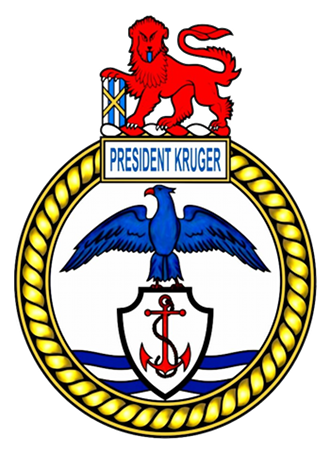SA FRIGATE GOES DOWN
(Cape Times Headline and report, Thursday February 18th, 1982)

The 2250 ton South African Navy frigate President Kruger has sunk 78 miles south-west of Cape Point after colliding with the 19000 ton fleet replenishment vessel, SAS Tafelberg, during night manouevers.
The collision happened at 4.22 am today and the frigate was abandoned soon afterwards when it became obvious she was about to sink. By mid-morning a huge air and sea rescue operation had recovered nearly all of President Kruger’s complement.
Although the Navy would not confirm how many were on board, it is believed to have been 193.
NOTE: The media reported what they knew at the time, and we make no appologies for factual errors contained in these reports. For example the collision took place at 03:55, and the ‘PK’ sank at 0435

The Day Before
Wednesday 17th February saw the continuation of a Submarine Office Commanding Course exercise 80 miles off Cape Point.
The Fleet replenishment vessel SAS Tafelberg, commanded by Captain Nick Smit, was being screened or protected by two frigates, SAS President Pretorius under the command of Captain Nick Vorster, and the Navy’s flagship, SAS President Kruger under the command of Captain Wim de Lange.
The submarine SAS Emily Hobhouse had the task of penetrating the protecting screen of frigates to ‘attack’ the Tafelberg.
The exercise had been planned to commenced at 06h00 and run until 23h00. Between these times, the frigates were tasked with carrying out specific manoeuvres to screen the Tafelberg, enabling the submarine to practise further tracking and attack manoeuvres.

The evening of the 17th saw a sea state that contributed to the disaster. The radar being used to monitor the exercise was not the main high definition radar, but the less accurate search radar.
The phenomenon known as clutter occurs when the radar signal is reflected back from objects that are not pertinent to the operators.
At sea, this includes the wave crests, and on that night the clutter obscured the centre of the radar screen and the surrounding area of almost 2000 metres.
This meant anything entering into this area would have been lost to the radar plot.

The two frigates task was to screen the ‘target’ vessel by performing specific manoeuvres reminiscent of the WWII convoy patrols. Specific course changes were to be followed, and the frigates were to patrol their sectors, altering speed and course while searching for the submarine.
A course change for the surface vessel was due at 04h00. This was a major change in that the fleet was required to turn almost 180 degrees, and the frigates would then have to re-position themselves around the Tafelberg. A similar course change had already taken place two hours earlier.
The senior ship was the President Kruger, and just before 04h00 passed the instruction for the frigates to change their course, whilst the Tafelberg was to remain on her current course until the completion of the escorts manoeuvre.
In effect, this is where the disaster started. The President Kruger had the option of turning away from the Tafelberg, but this meant that for the duration of the turn they may be turning away the submarine, or they could turn toward the Tafelberg.
Neither decision in itself was incorrect.
The Principal Warfare Officer on duty in the Operations Room, Lieutenant-Commander Pete Smith, was senior to Sub-Lieutenant Rob Pickstock acting as OOW, and instructed the OOW to undertake a turn toward the Tafelberg. The OOW carried out this order by issuing a command to alter rudder by 10 degrees, instead of the standard 15 degrees.

This application of 10 degrees starboard in itself was also not an incorrect order, as should it have become clear that the two ships were going to pass dangerously close to each other, the OOW would have been able to issue further course instructions.
However, it was at this point that the PWO entered into a difference of opinion and a discussion with the OOW, also described as an altercation, thereby distracting everyone on watch from the manoeuvre now being conducted.
It was also at this point that the radar clutter issue entered the equation, in that during the turn, the Ops Room lost the Tafelberg in the clutter, and had no concept of the approaching danger.
The OOW, Sub-Lt Pickstock, explained the rapdily developing situation to the PWO and suggested an alteration to the orders, but the PWO countermanded this.
The second in command of the President Kruger, Commander Myers, was on his way to take over the watch, and stopped by the Ops Room. By the time he reached the bridge, collision was unavoidable.

Sub-Lt Pickstock had already issued an order to turn to port, in an attempt to minimise the angle of impact, however this order was not executed by the Second Officer of the Watch.
Petty Officer Nic de Villiers, chief watchkeeper in the President Kruger’s boiler room, received an order for “Full Ahead”and complied.
30 seconds later, the President Kruger crossed the Tafelberg’s bow and was hit just aft of the hanger deck on the port side at 03:55.
The ship sank about 40 minutes later, rising out of the water and sinking stern first.
Out of a proud crew, 16 men lost their lives, and the lives of their friends on board, and their families, were forever changed.

Cameron Kirk Kinnear

